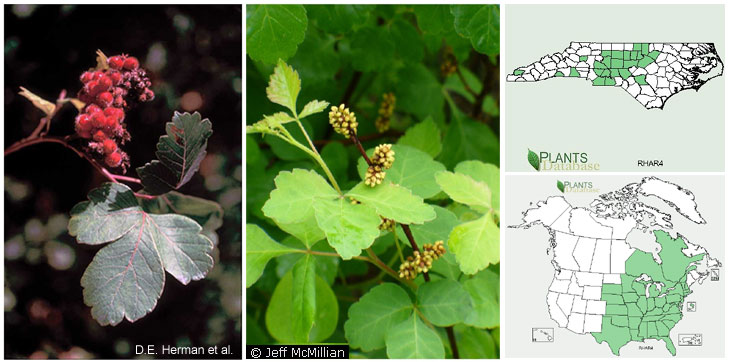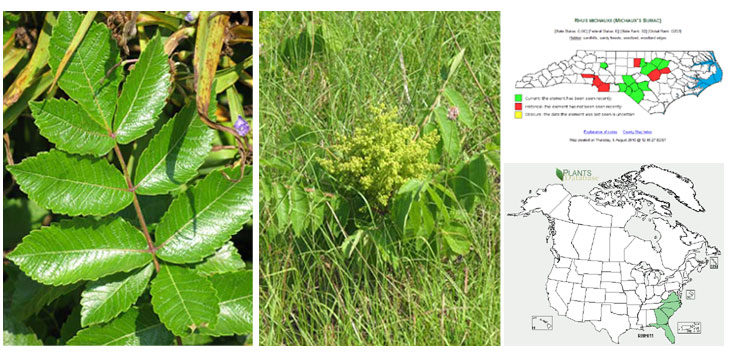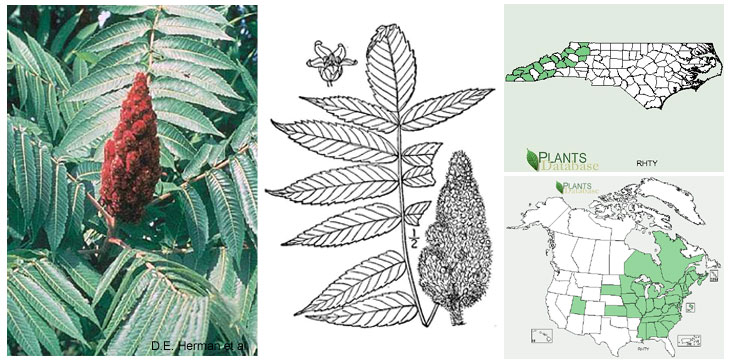Rhus L. (Anacardiaceae)
Rhus is represented by five species in North Carolina. The only species currently listed is Rhus michauxii (Fed E).
Note that there are three species in North Carolina that are now more often recognized in Toxicodendron, but that were previously considered by some in Rhus s.l. These three species are T. pubescens, T. radicans, and T. vernix. Toxicodendron can be distinguished from Rhus in part by the fruit color (white in Toxicodendron; red in Rhus).
Rhus aromatica is superficially very similar to Toxicodendron radicans and may be easily overlooked. Vegetatively, the two can be distinguished by the leaf bud. In R. aromatica, the bud is essentially hidden from view by the subtending leaf scar. In T. radicans, in contrast, the bud is usually easily visible and naked.
Federally listed taxon—
Rhus michauxii (Fed E, State E | S2 G2G3)
Habitat. Sandy or rocky, open woods over basic soil in areas with some disturbance (several populations along roadsides).
Range. Endemic to the southeastern United States.
Additional resources. NHP | Recovery plan | 5-yr review
Key to Rhus in North Carolina
Key adapted from Weakley (2008). Photos by Krings, unless otherwise indicated. Line drawings from Britton & Brown (1913). Maps courtesy of USDA PLANTS and the North Carolina Natural Heritage Program.
1. Leaves 3-foliolate...R. aromatica 


Habit of Rhus aromatica (Photo: Krings)

Stem of Rhus aromatica (Photo: Krings)

Hidden axillary bud of Rhus aromatica (Photo: Krings)

Leaves of Rhus aromatica (Photo: Krings)

Trifoliolate leaf of Rhus aromatica (Photo: Krings)

Leaf margin and adaxial surface of Rhus aromatica (Photo: Krings)

Inflorescence of Rhus aromatica (Photo: Krings)
Rhus aromatica (uncommon; rocky, dry woodlands, typically over mafic or calcareous rocks; Mt, Pd)
1’. Leaves (5–) 7–31-foliolate...2.
2. Leaf rachis winged between each pair of adjacent leaflets...R. copallinum 


Rhus copallinum (Photo: Krings)

Rhus copallinum (Photo: Krings)

Rhus copallinum (Photo: Krings)

Rhus copallinum (Photo: Krings)

Rhus copallinum (Photo: Krings)

Rhus copallinum (Photo: Krings)

Rhus copallinum (Photo: Krings)
Rhus copallinum (common; sandhills, woodlands, thickets, roadsides; Mt, Pd, CP)
2’. Leaf rachis not winged between each pair of adjacent leaflets or winged only between the terminal 1 or 2 pairs...3.
3. Leaflets densely pubescent (rarely sparsely pubescent); shrub short, to 1 m tall; stems densely long pubescent; leaf rachis frequently winged between the terminal leaflets; leaflets mostly ovate, acute...R. michauxii* 


Habitat of Rhus michauxii (Photo: Krings)

Habit of Rhus michauxii (Photo: Krings)

Stem and leaves Rhus michauxii (Photo: Krings)

Stem of Rhus michauxii (Photo: Krings)

Leaf of Rhus michauxii (Photo: Krings)

Leaf edge of Rhus michauxii (note hairs) (Photo: Krings)

Rhus michauxii (Photo: Krings)
Rhus michauxii*
(rare [Fed E, S2 G2G3]; submesic loamy swales, roadsides, sandy or mafic soils; Pd, CP; early summer to fall)
3’. Leaflets glabrous; shrubs to small trees, to 12 m tall; stems densely long pubescent or essentially glabrous; leaf rachis not winged; leaflets mostly lanceolate, acuminate...4.
4. Stems essentially glabrous; fruit pubescence short and blunt...R. glabra 


Habit of Rhus glabra (Photo: Krings)

Stem of Rhus glabra (Photo: Krings)

Stem of Rhus glabra (Photo: Krings)

Leaf of Rhus glabra (Photo: Krings)

Rachis of Rhus glabra (Photo: Krings)

Inflorescence of Rhus glabra (Photo: (c) 2002, Steven J. Baskauf, http://bioimages.vanderbilt.edu/)

Infructescence of Rhus glabra (Photo: (c) 2002, Steven J. Baskauf, http://bioimages.vanderbilt.edu/)
Rhus glabra (common [Mt, Pd], rare [CP]; disturbed areas, roadsides, woodlands; Mt, Pd, CP)
4’. Stems densely long-pubescent; fruit pubescence long and pointed...R. typhina 


Stem of Rhus typhina (Photo: Krings)

Stem of Rhus typhina (Photo: Krings)

Petiole of Rhus typhina (Photo: Krings)

Rachis of Rhus typhina (Photo: Krings)

Glabrous adaxial leaf surface of Rhus typhina (Photo: Krings)

Infructescence of Rhus typhina (Photo: Krings)

Infructescence of Rhus typhina (Photo: Krings)
Rhus typhina (common; roadsides, old pastures, thickets, outcrops, barrens; Pd, Mt)





